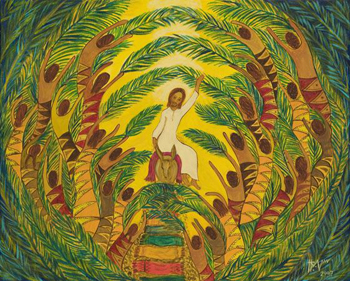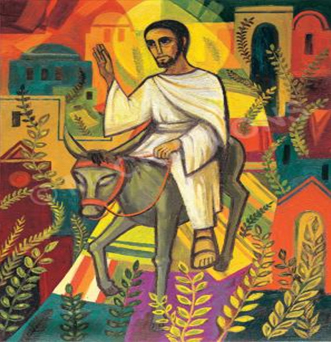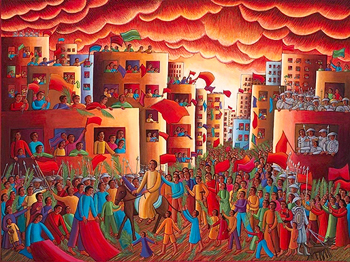For Sunday March 28, 2021
Lectionary Readings (Revised Common Lectionary, Year B)
Psalm 118:1-2, 19-29
Mark 11:1-11 or John 12:12-16
One of the lines I’ve heard often over the past few weeks is, “There’s light at the end of the tunnel!” I hear my neighbors saying it when I step out to walk my dog. I hear it in grocery stores, at the bank, on the news. After months of Covid-induced fear and isolation, we’re finally glimpsing hope as the vaccines roll out, the daily death tolls drop, and the restrictions on our social lives ease up. All of this is wonderful.
The other line I’ve heard, though, is this: “I can’t bear any more.” As in: “I can’t bear another Covid variant.” “I can’t bear another vaccine delay.” “I can’t bear another political scandal.” “I can’t bear another mass shooting.”
As ever, our lives slide from hope to disappointment, disappointment to hope. On the one hand, the light at the end of the tunnel revives and renews us. On the other hand, it shows us just how bleak and dismal the tunnel has been. In other words, it doesn’t take us human beings long to go from praise to pain.
What a fitting context for Palm Sunday, our entry into Holy Week. Today, we begin a journey that holds within it the fullness of the human story -- the highs, the lows, the hopes, the fears. In the span of seven days, we do it all: we praise, process, break bread, wash feet, make promises, break promises, deny, betray, condemn, abandon, grieve, despair, disbelieve, and celebrate. This week, we see the light at the end of the tunnel, lose our vision of it entirely in the grimness of death, and then find it again, drenched in glory.
Like many of you, I grew up celebrating Palm Sunday with loud, festive processions. As a child, I carried palm branches down the center aisle of my church, sang, "All Glory, Laud, and Honor” with my fellow parishioners, and shouted “Hosanna” at the top of my lungs. I did this without even knowing what the word, “Hosanna” meant. I assumed it meant some churchy version of “You’re awesome!” or “We love you!” or “Rock on, king of the world!”
 |
It doesn’t. In Hebrew, it means something far less cheery. It means, “Save now!” As in, “Lord, we’re desperate. We’re frantic. We’re in trouble. Our praise is steeped in need, want, loss, and lack. Hosanna, Jesus. Save us. Save us now.”
If you resonate with this plea as you come to the end of Lent, may I offer a word of reassurance? It’s okay. All of this -- all of this authentic hope wrapped in all of this honest fear -- is okay. It is what Holy Week is about. If the Palm Sunday story is about anything, it is about dazzling hopes and disappointed expectations. It’s a story about what happens when the God we want and think we know doesn’t show up, and another God — a less efficient, less aggressive, far less muscular God — shows up instead, and saves us in ways we didn’t know were possible.
Historians tell us that Jesus knew exactly what he was doing when he asked his disciples to secure a donkey for his journey down the mountain into the holy city. In their compelling book, The Last Week: What the Gospels Really Teach About Jesus' Last Days in Jerusalem, Marcus Borg and John Dominic Crossan argue that two processions entered Jerusalem on that first Palm Sunday two thousand years ago; Jesus's was not the only Triumphal Entry.
Every year during Passover — the Jewish festival that swelled Jerusalem's population from its usual 50,000 to at least 200,000 — the Roman governor of Judea would ride up to Jerusalem from his coastal residence in the west. He would come in all of his imperial majesty to remind the Jewish pilgrims that Rome demanded their complete loyalty, obedience, and submission. The Jewish people could commemorate their ancient victory against Egypt and slavery if they wanted to. But if they tried any real time resistance, they would be obliterated.
 |
As Pilate clanged and crashed his imperial way into Jerusalem from the west, Jesus approached from the east, looking (by contrast) ragtag and absurd. Unlike the Roman emperor and his legions, who ruled by force, coercion, and terror, Jesus came defenseless and weaponless into his kingship. Riding on a donkey, he all but cried aloud the bottom-line truth that his rule would have nothing to recommend it but love, humility, long-suffering, and sacrifice.
If there’s a single day in the liturgical calendar that illustrates the dissonance at the heart of our faith, it’s Palm Sunday. More than any other, this festive, ominous, and complicated day of palm fronds and hosanna banners warns us that paradoxes we might not like or want are woven right into the fabric of Christianity. God on a donkey. Dying to live. A suffering king. Good Friday.
These paradoxes are what give Jesus’s story its shape, weight, and texture, calling us at every moment to hold together truths that seem bizarre, counterintuitive, and irreconcilable. On good days, I understand that these paradoxes are precisely what grant my religion its credibility. If I live in a world that's full of pain, mystery, and contradiction, then I need a religion robust enough to bear the weight of that messy world. I need a religion that empowers me, in Richard's Rohr's beautiful words, "to live in exquisite, terrible humility before reality." But the question is: will I choose the humble and the real? Or will I insist on the delusions of empire? Will I accompany Jesus on his ridiculous donkey, honoring the precarious path he has chosen? Or will my impatience and pessimism undermine my journey?
In reference to Palm Sunday, Frederick Buechner writes this: “Despair and hope. They travel the road to Jerusalem together, as together they travel every road we take — despair at what in our madness we are bringing down on our own heads and hope in him who travels the road with us and for us and who is the only one of us all who is not mad.”
Buechner is right: we are mad with despair and hope, both, so much so that we don't know what to do with the story of a God who comes to die so that we can live.
 |
In the end, my solace is this: I am known and held by a God who is too big for thin, one-dimensional truths — even my own, most cherished, one-dimensional truths. I am held by a God who sticks with me even when I won’t stick with God. A God who accepts my worship even when it is mingy, half-baked, and selfish. A God who knows all the reasons my heart cries, “Save now!” and carries those broken, strangled cries to the cross on my behalf.
Welcome to Holy Week. Here we are, and here is our God. Here are our hosannas, broken and earnest, hopeful and hungry. Here is all that is unbearable, and all that promises to end in light brighter than we can imagine. Blessed is the One who comes to die so that we will live.
Debie Thomas: debie.thomas1@gmail.com
Image credits: (1) Mountain View UMC, Boulder, Colorado USA; (2) Patheos.com; and (3) simoncareyholt.wordpress.com.





